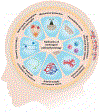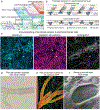Advances and controversies in meningeal biology
- PMID: 39333784
- PMCID: PMC11862877
- DOI: 10.1038/s41593-024-01701-8
Advances and controversies in meningeal biology
Abstract
The dura, arachnoid and pia mater, as the constituent layers of the meninges, along with cerebrospinal fluid in the subarachnoid space and ventricles, are essential protectors of the brain and spinal cord. Complemented by immune cells, blood vessels, lymphatic vessels and nerves, these connective tissue layers have held many secrets that have only recently begun to be revealed. Each meningeal layer is now known to have molecularly distinct types of fibroblasts. Cerebrospinal fluid clearance through peripheral lymphatics and lymph nodes is well documented, but its routes and flow dynamics are debated. Advances made in meningeal immune functions are also debated. This Review considers the cellular and molecular structure and function of the dura, arachnoid and pia mater in the context of conventional views, recent progress, and what is uncertain or unknown. The hallmarks of meningeal pathophysiology are identified toward developing a more complete understanding of the meninges in health and disease.
© 2024. Springer Nature America, Inc.
Conflict of interest statement
Competing interests
The authors declare no competing interests.
Figures



References
-
- Adeeb N, et al. The intracranial arachnoid mater : a comprehensive review of its history, anatomy, imaging, and pathology. Childs Nerv Syst 29, 17–33 (2013). - PubMed
-
- Engelhardt B, Vajkoczy P & Weller RO The movers and shapers in immune privilege of the CNS. Nature Immunology 18, 123–131 (2017). - PubMed
Publication types
MeSH terms
Grants and funding
- NS098273/U.S. Department of Health & Human Services | National Institutes of Health (NIH)
- R01 HL127402/HL/NHLBI NIH HHS/United States
- R01 HL143896/HL/NHLBI NIH HHS/United States
- 2020.0057/Knut och Alice Wallenbergs Stiftelse (Knut and Alice Wallenberg Foundation)
- 2018/1154/Swedish Cancer Foundation
- R01 HL059157/HL/NHLBI NIH HHS/United States
- HL127402/U.S. Department of Health & Human Services | National Institutes of Health (NIH)
- 2015-00550/Vetenskapsrådet (Swedish Research Council)
- 2018/449/Swedish Cancer Foundation
- HL059157/U.S. Department of Health & Human Services | National Institutes of Health (NIH)
- ALZ2019-0130/Hjärnfonden (Swedish Brain Foundation)
- R03 NS104566/NS/NINDS NIH HHS/United States
- 22CVD01/Fondation Leducq
- 211714Pj/Swedish Cancer Foundation
- ALZ2022-0005/Hjärnfonden (Swedish Brain Foundation)
- 310030_189080/Schweizerischer Nationalfonds zur Förderung der Wissenschaftlichen Forschung (Swiss National Science Foundation)
- HL143896/U.S. Department of Health & Human Services | National Institutes of Health (NIH)
- R01 NS131823/NS/NINDS NIH HHS/United States
- 23CVD02/Fondation Leducq
- R01 NS098273/NS/NINDS NIH HHS/United States
- 310030_189226/Schweizerischer Nationalfonds zur Förderung der Wissenschaftlichen Forschung (Swiss National Science Foundation)
- CRSII5_213535/Schweizerischer Nationalfonds zur Förderung der Wissenschaftlichen Forschung (Swiss National Science Foundation)

